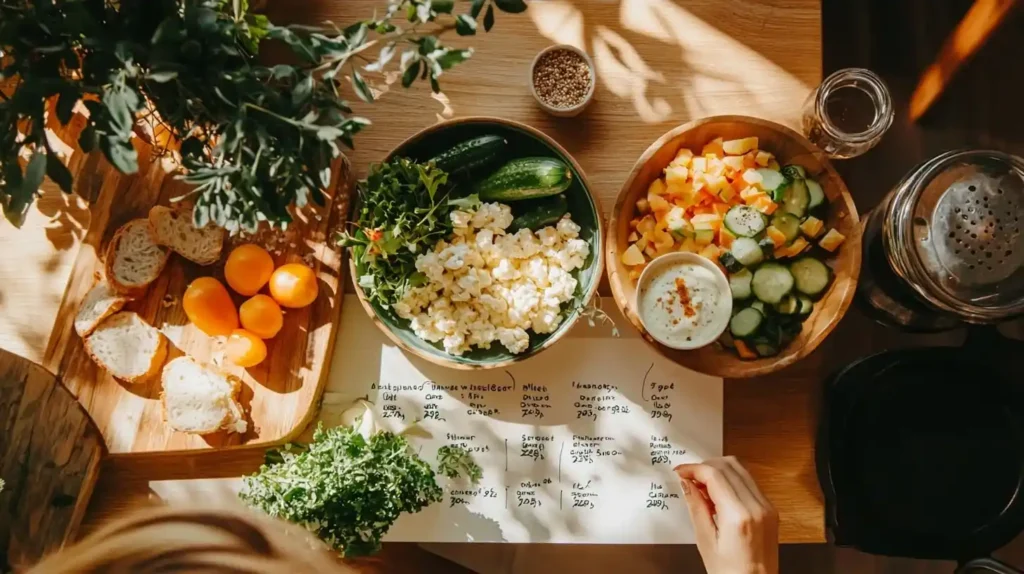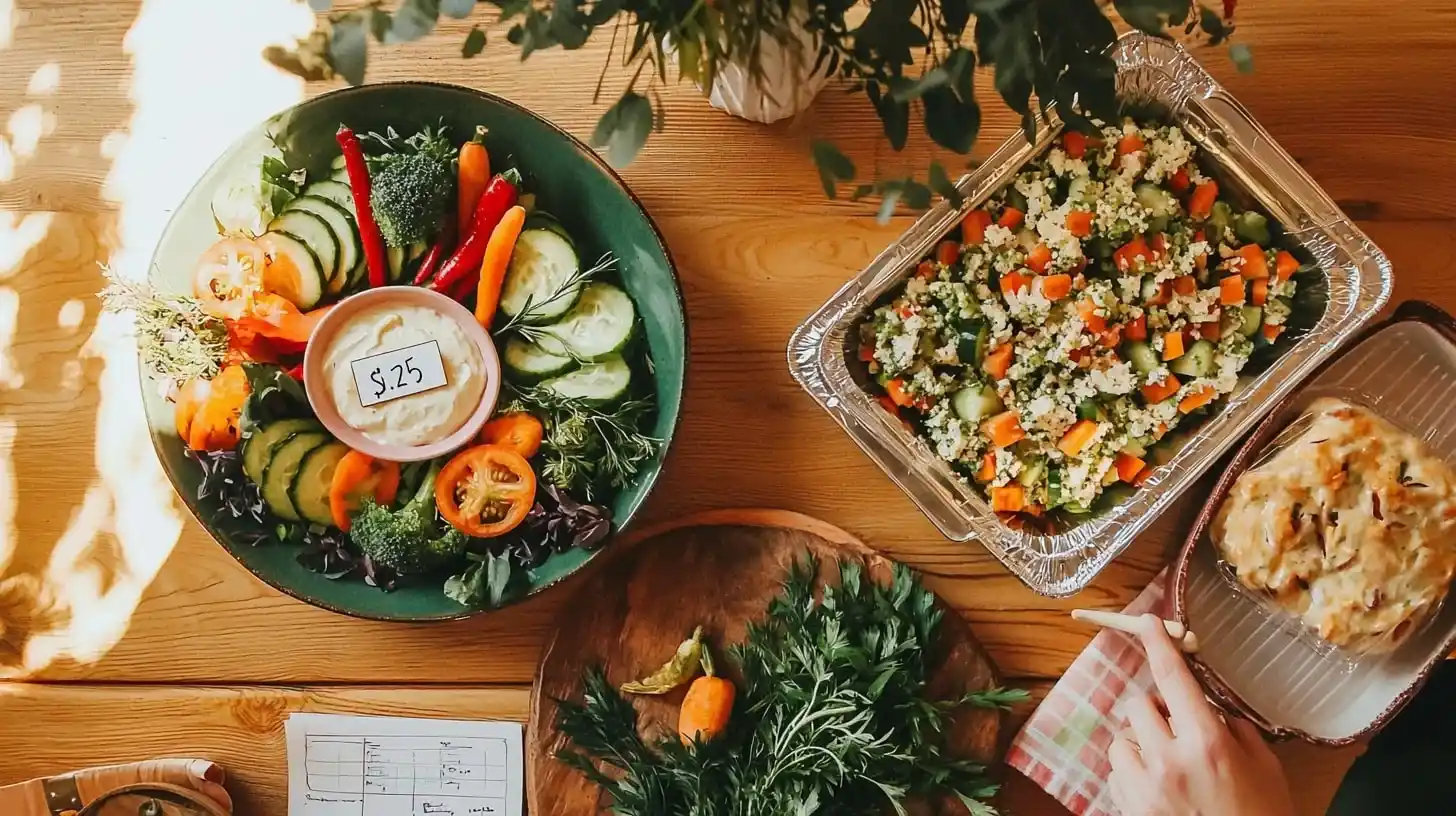“Twenty-five dollars for some cut vegetables?” my husband whispered in the grocery checkout line. His question about the pre-made vegetable tray on the conveyor belt sparked a kitchen investigation that changed my approach to entertaining.Is It Cheaper to Make or Buy a Veggie Tray?
With three children’s parties and school events requiring my contribution each month, pre-made vegetable trays had become my thoughtless go-to. Convenience often outweighed cost during busy parenting seasons, but was I spending double for the privilege of not washing a knife?
My Kentucky grandmother would have been disappointed in my failure to calculate this expense. “Mindful spending shows respect for your resources,” she’d say while transforming vegetables into beautiful arrangements during my childhood.
Table of Contents
Is It Cheaper to Make or Buy a Veggie Tray? The Real Cost of Convenience

Is It Cheaper to Make or Buy a Veggie Tray? The allure of pre-made vegetable trays is undeniable – they offer grab-and-go convenience during busy seasons of life.
My cost comparison journey began at three different grocery stores, where I found pre-made vegetable trays ranging from $19.99 to $29.99, with the average medium-sized tray priced at $24.99.
Their contents typically included carrots, broccoli, cauliflower, celery, a few cherry tomatoes, and a small container of ranch dip.
For more vibrant lunch options beyond vegetable trays, our Fresh & Vibrant Lunch Ideas: Colorful & Nutritious Options collection offers additional economical choices for your table.
Homemade vs. Store-Bought: Detailed Price Breakdown
Is It Cheaper to Make or Buy a Veggie Tray? Show Cost Comparison Image The numbers don’t lie – making your own vegetable tray saves nearly 50% while giving you control over freshness and quality!
After researching store-bought options, I purchased the same vegetables individually and prepared my own Vegetable Tray following my grandmother’s rainbow arrangement technique.
Homemade Vegetable Tray (Serves 10):
- 2 bell peppers ($1.50)
- 1 bunch of carrots ($0.99)
- 1 English cucumber ($0.75)
- 1 broccoli crown ($1.99)
- 1 pint cherry tomatoes ($2.50)
- Snap peas ($1.99)
- Homemade ranch dip ingredients ($3.03)
- Total: $12.75 ($1.27 per serving)
Store-Bought Vegetable Tray (Serves 10):
- Pre-packaged tray with dip: $24.99 ($2.50 per serving)
- Total Savings: $12.24 (nearly 50%)
My middle child calculated that if we purchase homemade vegetable trays twice monthly for a year, we’d save nearly $300 – “enough for our family movie passes for the whole year,” she noted with practical wisdom.
When preparing your own tray, questions like Do I peel cucumbers for a veggie tray? may arise – a detail affecting both presentation and preparation time.
Additional Factors Beyond Price
Is It Cheaper to Make or Buy a Veggie Tray? While the cost savings are compelling, several other factors strengthen the case for DIY preparation:
Freshness: Store-bought trays often sit for days before purchase, while homemade versions can be prepared within hours of serving.
Customization: Homemade trays allow you to include family favorites and accommodate allergies or preferences. When my youngest only ate orange vegetables, our homemade trays featured additional carrots and orange bell peppers.
Quantity: Homemade trays typically contain significantly more vegetables for the price. My husband once weighed both options, finding nearly 40% more food in the homemade version.
Presentation: For those wondering What is a fancy vegetable tray called?, the term “crudités” describes this elegant offering – and homemade versions allow for artistic arrangements beyond plastic containers.
For more economical meal solutions, our Family-Friendly Lunch Recipes: Effortless Meals for Busy Parents collection offers additional ideas balancing quality, cost and convenience.
When Store-Bought Makes Sense
Is It Cheaper to Make or Buy a Veggie Tray? My grandmother’s practical wisdom acknowledged that sometimes convenience justifies additional expense. Several scenarios might warrant purchasing pre-made trays:
Time constraints: During my daughter’s dance recital week, I gratefully purchased pre-made options rather than adding another task to my midnight food preparation.
Travel considerations: For a beach gathering last summer, the pre-made tray prevented sandy, cramped preparation.
Kitchen limitations: During our family reunion at a cabin with minimal kitchen equipment, store-bought trays allowed us to enjoy fresh vegetables without packing tools.
My husband calls this the “convenience tax” – sometimes worth paying, but always a conscious choice rather than an unconsidered habit.
Answers to Your Vegetable Tray Cost Questions
Does the cost difference justify the preparation time? With approximately 15-20 minutes of preparation time, the $12 savings represents a substantial return on investment. My sister calculated this as earning approximately $40 per hour – more than many professional rates.
What about the cost of the serving platter? While attractive serving pieces enhance presentation, they represent a one-time investment. My sage green ceramic platter cost $12 five years ago and has served countless arrangements, making its per-use cost pennies.
Are there ways to reduce costs even further? Seasonal shopping significantly impacts vegetable costs. My grandmother taught me to “follow the seasons” for best prices. Additionally, shopping at farmers’ markets or discount grocers can reduce costs another 15-20%.Is It Cheaper to Make or Buy a Veggie Tray?
Making Budget-Friendly Choices for Family Gatherings
The question of whether Is It Cheaper to Make or Buy a Veggie Tray? has a clear answer: homemade versions typically cost about half as much while offering advantages in freshness, quantity, and customization.
My grandmother’s approach to household economics always balanced multiple considerations. “Sometimes the cheapest option costs too much in other ways,” she’d remind me when I’d focus exclusively on dollar amounts.
For our family, homemade vegetable trays have become the standard choice for regular gatherings, while store-bought versions remain an occasional convenience during particularly demanding seasons.
This balanced approach represents thoughtful consumption – evaluating true costs versus convenience benefits leads to wiser choices aligned with your family’s priorities and resources.
With warmth,
Sophia





